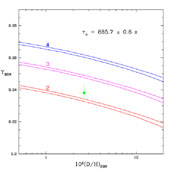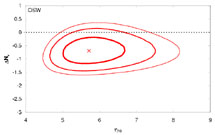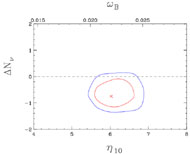


4.2. Nonstandard Expansion Rate: S
 1
(
1
( N
N
 0)
0)
The excellent agreement between the SBBN-predicted baryon density
inferred from the primordial-D abundance and that derived from
the CBR and large scale structure
(Spergel et al. 2003),
and also the agreement between predicted and observed D and
3He suggest
that the tension with 4He, if not observational or astrophysical
in origin, may be a sign of new physics. As noted earlier, YP
is sensitive to the early-Universe expansion rate (while D, 3He,
and 7Li are less so). A faster expansion (S > 1,
 N
N ;> 0)
leads to a higher predicted primordial abundance of 4He, and
vice versa for S < 1
(
;> 0)
leads to a higher predicted primordial abundance of 4He, and
vice versa for S < 1
( N
N <
0). In Figure 12 is shown the
same YP versus yD band as for SBBN in
Figure 10,
along with the corresponding bands for the nonstandard cases of
a faster expansion (
<
0). In Figure 12 is shown the
same YP versus yD band as for SBBN in
Figure 10,
along with the corresponding bands for the nonstandard cases of
a faster expansion ( N
N = 4) and a
slower expansion (
= 4) and a
slower expansion ( N
N = 2).
It can be seen that the data "prefer" a slower than standard
early-Universe expansion rate. If both
= 2).
It can be seen that the data "prefer" a slower than standard
early-Universe expansion rate. If both
 and
and
 N
N are
allowed to be free, it is possible (not surprisingly) to accommodate the
adopted primordial abundances of D and 4He (see
Fig. 2).
Given the similar effects of
are
allowed to be free, it is possible (not surprisingly) to accommodate the
adopted primordial abundances of D and 4He (see
Fig. 2).
Given the similar effects of
 N
N
 0 on the BBN-predicted D,
3He, and 7Li abundances, while it is possible to
maintain the good agreement (from SBBN) for 3He, the tension
between 7Li and D cannot
be relieved. In Figure 13 are shown the 1-, 2-,
and 3-
0 on the BBN-predicted D,
3He, and 7Li abundances, while it is possible to
maintain the good agreement (from SBBN) for 3He, the tension
between 7Li and D cannot
be relieved. In Figure 13 are shown the 1-, 2-,
and 3- BBN contours in
the
BBN contours in
the  -
-
 N
N plane derived
from the adopted values of yD and
YP. Although the best-fit point is at
plane derived
from the adopted values of yD and
YP. Although the best-fit point is at
 N
N = -0.7
(and
= -0.7
(and  10
= 5.7), it is clear that SBBN
(N
10
= 5.7), it is clear that SBBN
(N = 3) is
acceptable.
= 3) is
acceptable.
 |
Figure 12. As in
Figure 10 for
N |
 |
Figure 13. The 1-, 2-, and
3- |
The CBR temperature anisotropy spectrum and polarization are also
sensitive to the early-Universe expansion rate (see, e.g.,
Barger et al. 2003a,
and references therein). There is excellent overlap
between the  -
-  N
N confidence
contours from BBN as shown in
Figure 13 and from the CBR
(Barger et al. 2003a).
In Figure 14 are shown the confidence contours
in the
confidence
contours from BBN as shown in
Figure 13 and from the CBR
(Barger et al. 2003a).
In Figure 14 are shown the confidence contours
in the  -
-
 N
N plane for
a joint BBN - CBR fit
(Barger et al. 2003a).
Again, while the best fit value for
plane for
a joint BBN - CBR fit
(Barger et al. 2003a).
Again, while the best fit value for
 N
N is negative
(driven largely by the adopted value for YP),
is negative
(driven largely by the adopted value for YP),
 N
N = 0 is quite
acceptable.
= 0 is quite
acceptable.
 |
Figure 14. The 1- and
2- |